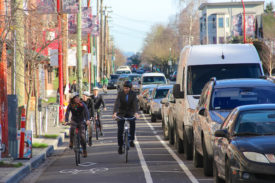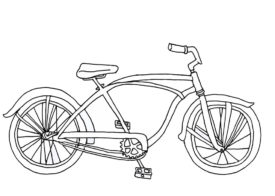Some unfinished business: I’ve been thinking and writing about Bicycle Neglect now for half a year, and I still have not defined the term—an oversight that I’ll rectify right away.
Bicycle Neglect is a syndrome with four mutually reinforcing symptoms:
- A tendency to view bicycles as a form of recreation, not a form of transportation (this is typically a manifestation of Car-head);
- An institutional, legal, and physical environment explicitly or unwittingly hostile to bicycling for transportation (typical features include car-oriented traffic laws, car-oriented traffic policing, woefully inadequatebikingfacilities, and miserly budgets to improve these facilities);
- Unnecessarily dangerous conditions for cycling; and
- Very low levels of bicycling for transportation, as a result.
Bicycle Respect is Bicycle Neglect’s opposite, on each count:
- A tendency to view bicycles as a form of transportation, not just recreation;
- An institutional, legal, and physical environment supportive of bicycling for transportation, including bike-friendly traffic laws and policing, ample biking facilities, and adequate budgets to improve these facilities;
- Safe conditions for cycling; and
- High levels of bicycling for transportation, as a result.
Nothing more to say here: this series just needed a glossary.









Sea
I would include some of the thing that happen whenever bicycle improvements are proposed. 1) Fear of loosing parking spots. (As if parking is a best use for a public right of way.) 2) Fear of attracting bad element to the area. 3) That bicyclist are considered a bad element. 4)Fear that property values will go down. (They always go up.) 5) Something I don’t understand, an almost insane hate for bicyclist by the people opposed to bicycle improvements.
Aaron Antrim of Green Wheels
I’d like to add another symptom of bicycle neglect. In my area (Humboldt County), when traffic is studied, volumes are measured for automobiles, but not for cyclists, and traffic safety is considered in terms of motor vehicle accidents but not for cyclists and pedestrians. A related, but different, issue is that reducing (automobile) vehicle miles traveled (VMT) is not considered as a strategy for improving safety. One would expect that fewer vehicle miles driven would result in fewer accidents. Instead, traffic engineers usually focus exclusively on reducing accidents per vehicle mile traveled. This is an important focus, but should not be exclusive.